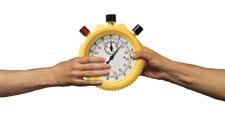POINT: Shawn P. DeRosa
One school of thought suggests that swimming pool lifeguards must scan their zone of coverage in 10 seconds and respond to persons in need within the next 20 seconds. The “10/20 Protection Rule” advanced by Jeff Ellis & Associates attempted to set a black-and-white standard for lifeguard surveillance at public pools and waterparks.
But the 10/20 rule offers a somewhat flawed, two-pronged approach to reduce drowning rates by (1) attempting to enforce a vigilant surveillance standard while also (2) positioning lifeguards for rapid response to an incident.
The 10/20 rule is frequently misinterpreted — often by plaintiff’s attorneys — to suggest that guards who do not scan their zones within 10 seconds or who cannot reach a victim in 20 seconds are not performing their jobs correctly. As was later proven through research by Poseidon Technologies and Jeff Ellis & Associates, the 10/20 rule is not able to accurately assess whether lifeguards scan correctly.
Guards evaluated under this so-called “standard” often moved their heads from left to right and even swept the areas beneath their stands in order to pass the audits, but were not watching the water with the level of perception expected. Research by Ellis and Poseidon Technologies showed most lifeguards were unable to identify manikins left within their zones in the 10-second time frame even though their heads moved in what would otherwise appear to be an acceptable pattern, scanning the zone every 10 seconds. They were scanning, but they weren’t really seeing.
In fact, during the first year of testing, the average time to spot a manikin dropped within a guard’s zone of coverage was 1 minute 14 seconds — well beyond the 10-second requirement. Thus, the 10-second scan requirement not only proved difficult to evaluate, but also was shown to inadequately assess the very thing people hoped it would do: help prevent drownings. Something more than a mere time frame for a visual scan was needed.
In considering the results of five years of testing, it is now clear that the 10-second scanning component of the 10/20 rule is not the “standard” that it purports to be. Much more is involved in victim recognition than simply defining a time frame for scanning a zone and then attempting to correlate that time to a standard for victim recognition. The time it takes to scan a zone may be very different from the time it takes to recognize a patron in need of assistance. Factors such as fatigue, glare, shadows and naturally occurring surface disturbances, which cause reflection and refraction of light, complicate victim recognition.
The second element of the 10/20 rule is that guards must respond to a victim in distress within 20 seconds. This requires that a lifeguard station be positioned so a guard can reach all areas of his or her zone within 20 seconds.
The trouble is that in recent years, aquatics managers in the United States report a decline in the swimming abilities of many lifeguard applicants, in part because of what they perceive to be reduced swimming proficiencies required by lifeguard training organizations. Many novice guards simply lack the strength and speed required to meet the 20-second requirement, especially when working in a waterpark environment, where wave pools can create surflike conditions.
Rather than require a scientifically unproven time frame for guards to scan their zones and respond in emergencies, aquatics managers would be well advised to use the 10/20 rule as a guideline to assist in developing reasonably sized zones and appropriate lifeguard staffing patterns.
Guards who proactively scan their zones and change their posture and position every five minutes send a professional message to pool patrons while also helping to increase their respiratory and cardiac rates, thereby keeping themselves more alert. A heightened level of alertness is an important factor in scanning effectiveness.
Alertness, or vigilance, is important because cases show that properly positioned lifeguards have missed persons submerged on the bottom in part because not all victims demonstrate visual signs of distress at or near the surface, but rather, begin their struggle underwater, where at times it is difficult to be seen by a guard whose view of the bottom is disturbed by surface agitation of water and glare from the sun.
Visual awareness training tools that prioritize a sweep of the pool bottom or that show guards what to look for beneath the surface, such as a smudge, are helpful in teaching them how to scan while also encouraging behaviors that help keep them alert and focused on the job.
But to suggest that the 10/20 rule is the recognized standard of care applicable to the entire lifeguarding industry is inappropriate. The 10/20 rule appears only in the Ellis & Associates “International Lifeguard Training Program.” A slightly modified version also appears in the Starfish Aquatics Institute’s StarGuard course, an offshoot of the E&A program. The American Red Cross, YMCA and NASCO lifeguarding programs, which collectively certify more than 90 percent of lifeguards in the United States, make no mention of 10/20 rule.
When used to identify crowded conditions and the resulting need for backup coverage or to help define reasonably sized zones of coverage, the 10/20 rule serves as a helpful management tool. However, when confused as a standard for visual awareness and victim recognition, the 10/20 rule becomes not a standard for lifeguard staffing patterns, but rather, a weapon for plaintiff’s attorneys.
COUNTERPOINT: Michael Oostman
On 1983, Jeff Ellis and other aquatic training professionals began addressing significant safety issues regarding lifeguard practices. One problematic theme continued to surface in their efforts: a lack of objective scanning and response time standards. Historically, lifeguard performance standards were confusing, arbitrary or, worse, absent.
This disturbing revelation was the stimulus behind the development of what is known today as the 10/20 standard. This standard requires professional lifeguards to recognize a distressed guest within 10 seconds, and reach that person and begin care within 20 seconds. These timelines were the result of significant discussion, disagreement and eventually consensus.
For the first time, lifeguard training programs using the 10/20 standard included a single objective and measurable performance standard. Lifeguard performance audits then were developed using a measurable benchmark, not historically ambiguous or subjective criteria. Guards and managers knew immediately how their performance compared with a standard. It opened the door for more effective remediation programs and improved risk management.
Validation was the next logical progression in the development of the 10/20 standard. In 2001, Poseidon Technologies investigated the impact of the 10/20 standard. More than 500 Ellis & Associates client aquatics facilities participated in this study throughout the United States. We found an average response time of 74 seconds for guards to recognize the manikin at the bottom of a pool. This data strongly supported the notion that lifeguard training wasn’t achieving the student learning outcomes required for improved drowning prevention, a clearly unacceptable performance by any criteria.
Several contributing or intervening factors were suggested as influencing this unacceptable performance level. They included:
- Environmental conditions
- Biological elements
- Problematic lifeguard placement
- Distressed guest detection training.
In 2001, we went to work on the development of additional training curricula to address these factors. Vigilance Awareness Training was the result of this effort and quickly became a required lifeguard training element for our Comprehensive Program Clients. While it was still a voluntary program during the 2002 season, we measured an average total response time of 56 seconds in E&A client facilities. In 2003, as the VAT program became mandatory at all E&A client facilities, the average total response time dropped to 24.7 seconds (600 tests); in 2006, the average response time was 18.9 seconds (1,000 tests). It is important to note that the time data collected represents the aggregate total of recognition and rescue time values.
Clearly, the 10/20 standard became the primary force behind the development of additional lifeguard training curricula, designed to improve response times. Using the VAT program and holding guards accountable to the 10/20 standard means they are now better equipped to recognize a distressed guest and intervene in measurable timelines.
The 10/20 standard began the process of requiring measurable criteria of lifeguard response time performance. We, along with other aquatics professionals, developed this standard. Reversing course and discontinuing the advancement of objective lifeguard performance standards will only take the aquatic training industry backward, resulting in indefensible positions when a specific guard’s performance is called into question.
We realize and embrace the reality of changing standards. As the industry matures, verifiable evidence supporting improved outcomes, based on validated standards, must become the golden “standard.”
Ultimately, for our team and the Comprehensive Program Clients, the only outcome that matters is zero drownings. We continue to support and encourage the development and validation of all aquatic standards that clearly demonstrate improved drowning outcomes. We strongly support the 10/20 standard and its associated training curricula, and invite anyone to improve guest protections standards. We look forward to the challenge.



